The best ways to treat eggplant diseases: photo and description
Eggplant diseases, like attacks by insect pests, can kill plants and leave hosts without crops. To effectively cope with diseases, you need to know their first signs and methods of treatment. Also, do not forget about prevention - this is the best remedy against infections and pests.
In the article you will find descriptions, causes and symptoms of the most common eggplant diseases with photographs and learn how to treat diseases.
The content of the article
How to understand if eggplant is sick
Any change in the shape and color of the trunk, leaves, flowers and fruits of a plant is a serious reason to pay attention to the health of the plantings. The appearance of stains is another sign that cannot be ignored. If the eggplant gets sick during the flowering period, it flowers shrink, dry out and fall off.
Fungal diseases are the most common and can be effectively treated. Bacterial infections can also be dealt with. Viral diseases are contagious and difficult to treat. They are fought with, destroying diseased bushes, disinfecting garden tools.
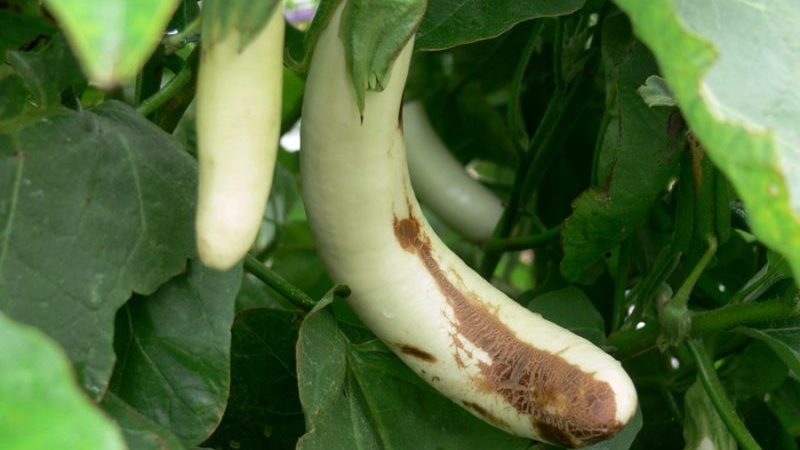
Causes of diseases
Being a thermophilic plant, eggplant is demanding to care for. Any deviation from the rules of agricultural technology leads to weak plantings and subsequent diseases:
- Lack of sunlight. Each period of eggplant development requires a certain amount of light. So, for seedlings, the optimal duration of daylight hours is 10 hours, otherwise the plant withers and gets sick. Bushes on which fruits ripen also need sufficient sunlight. Planting bushes is best done on the sunny side of the site. Eggplants do not grow or develop in the shade.
- Water scarcity. Do not allow the soil to dry out or boggy. Seedlings need watering 3 times a week. In the heat - every other day. Bushes with ripe fruits are watered once a week - about 4 liters of water per bush.
- Watering with too cold water. It causes not only diseases, but also the death of the plant. The reason is the lack of heat required for full growth and development. The root system is active exclusively in warm soil. Water heated in the sun is used for irrigation.
- Lack of nutrients. A lack of potassium causes leaves to curl and a brown rim to appear at the edges. A change in their color to a lighter color indicates a nitrogen deficiency. Leaves stretching upward indicate a lack of phosphorus. The absence of any of the elements is an inadequate nutrition of the plant, which causes a weakening of the immune system.
- Other reasons include insects, which not only eat plants, but also act as carriers of infections.
Diseases of eggplant and their symptoms
Start the fight against any disease in a timely manner. The sooner the signs of the disease are noticed, the more successful the fight will be, the faster recovery will come and the fruiting will be restored. Consider eggplant diseases with photos and how to treat them.
Rolling the leaves
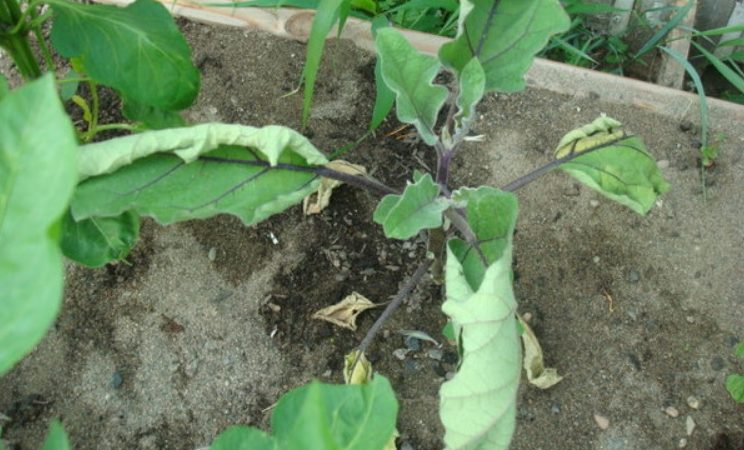
Rolled eggplant leaves indicate:
- Insufficient watering.Moistening the soil must be carried out as soon as the top layer dries.
- Nutrient Deficiency. 1 tsp ash under each bush helps to get rid of deformed leaves.
- Excess fertilizer with little irrigation. If the soil is oversaturated with nitrogen, phosphorus and potassium, and watering is poor, leaves begin to curl up and dry. In this case, fertilizing is canceled and the number of waterings is increased.
- Changes in soil temperature or moisture. By adapting, the plant will straighten its leaves without help.
Blackleg
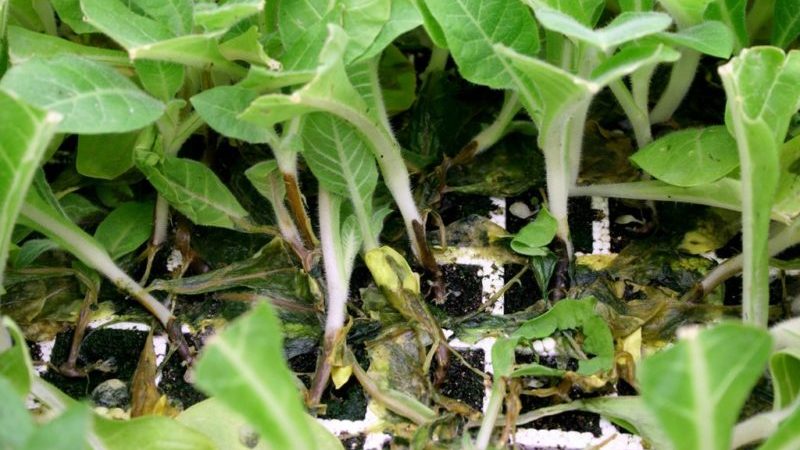
A fungal infection that attacks young plants. It manifests itself as a dark stripe on the lower part of the stem. The trunk dries up in this place, and the eggplant dies. The provoking factor is excess moisture in the soil, which contributes to the development of the fungus.
A plant affected by a black leg cannot be cured.... It is removed and the soil is treated with a solution of potassium permanganate, "Maxim", "Previkur". To remove excess moisture, sprinkle the earth with a small amount of sand.
Popular methods of struggle include spraying with infusion of onion peels and processing the soil with ash once a week.
Yellow leaves
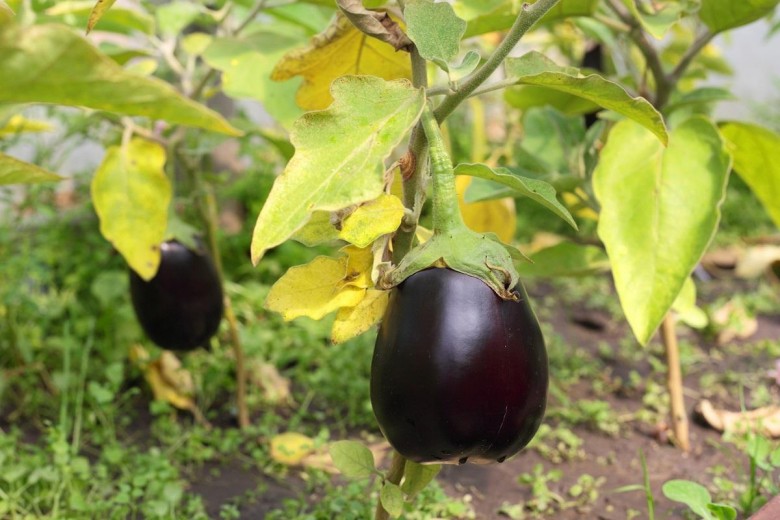
The yellowness of the leaves can appear both in seedlings and in an adult plant. The absence of other signs indicates:
- insufficient soil moisture;
- lack of potassium and nitrogen;
- using cold water for watering;
- unsuitable soil for seedlings.
Preventive measures - timely and dosed application top dressing, planting seedlings in sterilized and acidic soil.
Important! Yellow foliage, accompanied by other signs, always indicates the presence of a disease in the plant. The absence of additional symptoms indicates a violation of the rules of agricultural technology.
Black spot
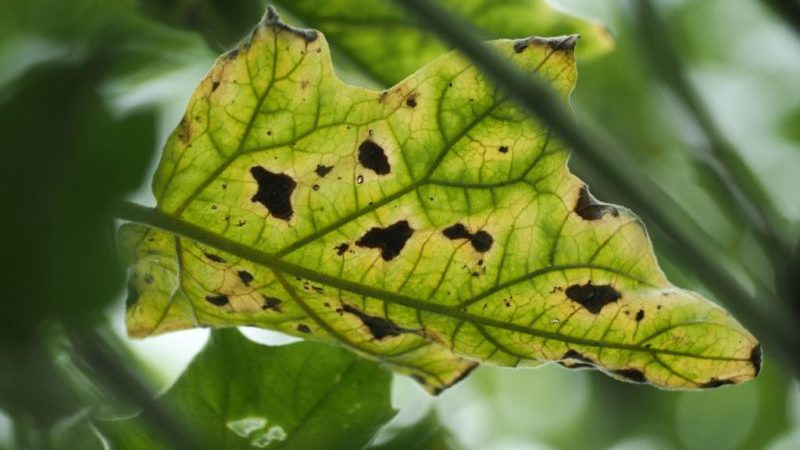
A dangerous bacterial disease that affects eggplants at any stage of development. High humidity is the main cause of the disease.
The first symptoms are small black spots on the leaves with a yellow border. After 7-10 days, they acquire a convex shape. 2 weeks after that, if treatment is not started, the plant becomes covered with ulcers.
For treatment use "Fitolavin" every 2 weeks and "Gamair" once.
Attention! Not only diseased plants are subject to processing, but also the soil around. All vegetation remains must be removed and destroyed.
Powdery mildew
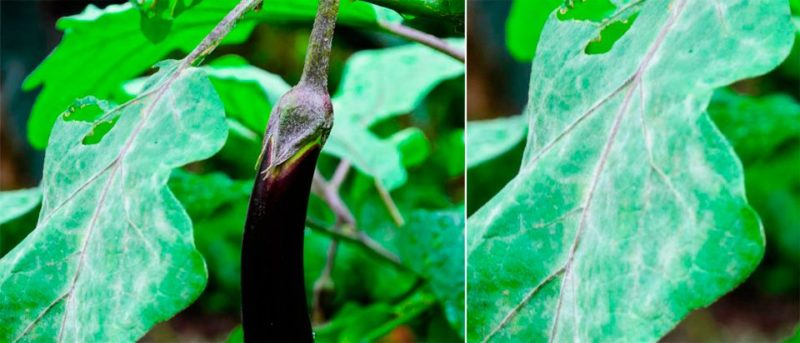
Powdery mildew on eggplants is caused by a fungus that becomes active during periods of high humidity with frequent temperature fluctuations. A white bloom appears on the upper side of the leaves, resembling spilled flour. Over time, the leaves dry out, fall off, and the bush itself withers.
Reference. White bloom on the underside of the leaves is downy mildew, or downy mildew.
As a treatment, spraying with a solution of colloidal sulfur or Topaz is used. Apply in accordance with the instructions. It is necessary to reduce the number of waterings.
A popular way to combat powdery mildew is to scatter ash over the surface of the beds and around them.
Tobacco mosaic
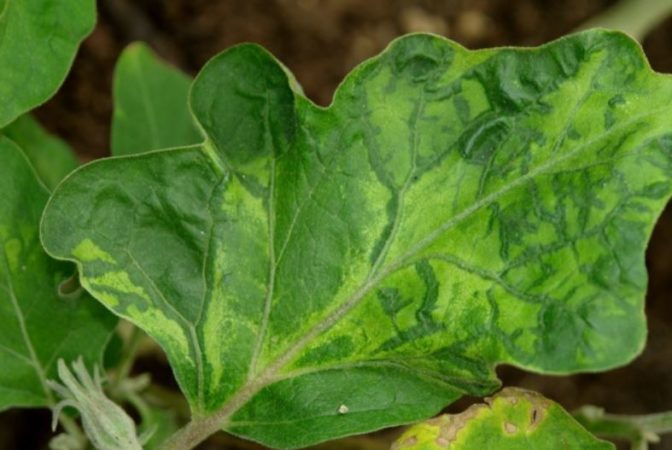
One of the diseases that insects carry. Very contagious. The pathogen persists for a long time on plant residues.
It is manifested by the following symptoms:
- deformation and pallor of the leaves;
- spots of dark and light green colors, similar to a mosaic;
- over time, holes appear on the leaves;
- the growth of fruits slows down, they are covered with yellow spots.
The disease spreads through infected seeds. As a preventive measure, before sowing, they are soaked for 30 minutes in a 20% hydrochloric acid solution, after which they are washed under running water.
Treatment is carried out with the drug "Fitosporin" or "Uniflor-micro"... A folk remedy is a solution of milk with laundry soap. They are sprayed with plants every 10 days.
Phomopsis
Caused by a fungus in high humidity and high temperatures. It appears as round light spots on the leaves and trunk. Gray and brown spots appear on the fruits, which rot and become covered with mucus.
Diseased plants are removed from the garden and destroyed. There is no effective treatment, it is necessary to carry out prevention in order to prevent the disease. For this, the seeds are disinfected before landing, the plants are periodically treated with "Fundazol" and "Derozal".
Late blight
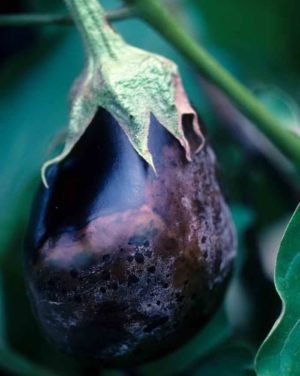
A common disease that spreads from all nightshades to each other. The most striking symptoms are:
- dark spots with bright green edging on foliage;
- white-gray bloom on the underside of the leaves;
- spots cover the stems and fruits, causing rotting.
To combat, drugs containing copper, Bordeaux liquid are used. "Quadris" and "Antracol" have proven themselves well.
Folk remedies include spraying with serum, infusion of garlic, dusting with wood ash.
Alternaria, or gray rot
First of all, the fruits growing at the bottom of the bush are affected. Weeping brown spots appear on them, which later pass to the foliage.
Treat with "Horus" and "Antracol" in accordance with the instructions for use. For prevention, it is treated with colloidal sulfur, Fitosporin, and copper sulfate.
Sclerotinosis, or white rot
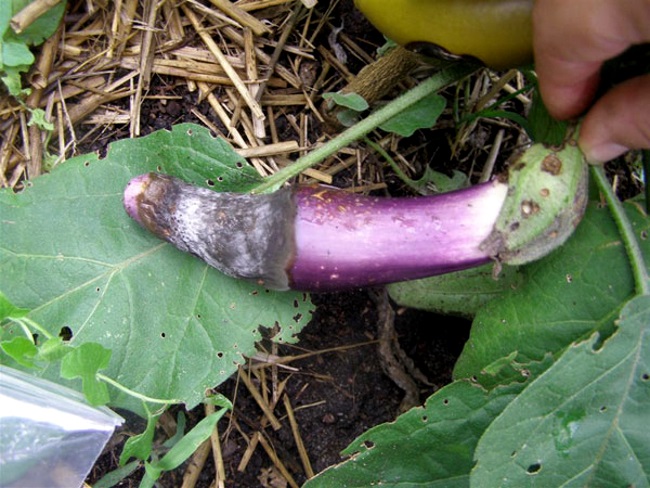
The fungus that causes white rot is common throughout the continent and affects a large number of plants. The foliage of eggplants brightens, the trunks rot at the base, a white bloom with black dots forms, the fruits are covered with white spots.
Treatment of white rot on eggplants involves spraying with Oxyhom, HOM or Abiga-Peak preparations. It is also necessary to prune the affected parts of the bush.
Folk remedies include spraying with a weak solution of potassium permanganate or iodine.
Vertex rot
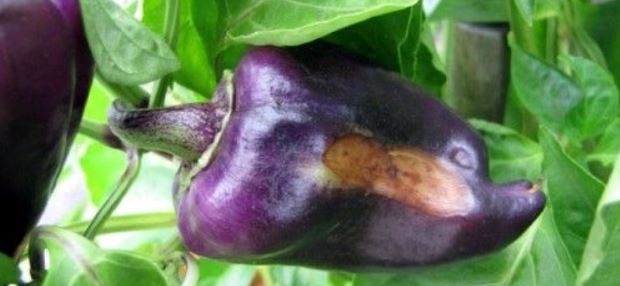
Refers to viral infections. On the lateral side of the fruit, necrotic spots are formed. They are watery, but as they grow, they dry out.
Treatment consists in applying fertilizers containing potassium and calcium to the soil. Affected leaves and fruits must be removed. For the prevention of top rot, watering at the root and spraying the bushes with ash infusion are used.
Cercosporosis
Fungal disease manifested by small yellow spots on the leaves. Overgrowth of spots causes foliage to die. Fruits stop in development, are deformed.
Bordeaux mixture is very effective at the initial stage of the disease. In advanced cases, the drugs "Skor", "Raek", "Fundazol" are used. Be sure to apply mineral fertilizers.
Phytoplasmosis
A viral infection that cannot be treated. The affected bushes are removed and burned. The disease manifests itself by staining the foliage in purple-reddish shades, cracks form on the leaves. Fruits are hard, deformed.
You can prevent the disease by clearing the area of all weeds and plant debris before planting. Insects that carry the virus are destroyed with insecticides.
Verticillary wilting
Insects are carriers of the disease. The pathogens remain in the soil and on plant debris. A sharp change in weather serves as an impetus for the development of the disease.
A blackening stem with secreting mucus, withering yellow foliage are signs of verticillary wilt.
In order to prevent disease, the plants and the soil under them are sprayed with a solution of potassium permanganate or "Fitosporin". Insecticides are used to kill insects. Complex mineral fertilizers are required.
Internal necrosis
Viral infection leading to fetal mummification. Mature plants cannot be restored. This disease cannot be cured, but it can be prevented. For this, the seeds are kept in 20% hydrochloric acid solution for 30 minutes before planting. Then washed in running water and dried.
The main types of eggplant pests
Insect pests not only carry viral infections, but also destroy the foliage and fruits of eggplants. Insects reproduce very quickly and are capable of completely destroying plantings.
Let's talk about the pests that affect eggplants and how to deal with them.
Aphid
These are small green bugs with a soft body that feed on the sap of the plant. They form colonies on the inside of the leaves, which curl up and dry out as the colonies grow. Lack of nutrients leads to the death of the entire plant.
Insecticides "Karbofos" and "Keltan" completely destroy aphids. Adherents of folk methods of struggle use spraying with onion broth and tincture of tobacco ash. You can wipe the leaves with a solution of laundry soap and ash.
Colorado beetle
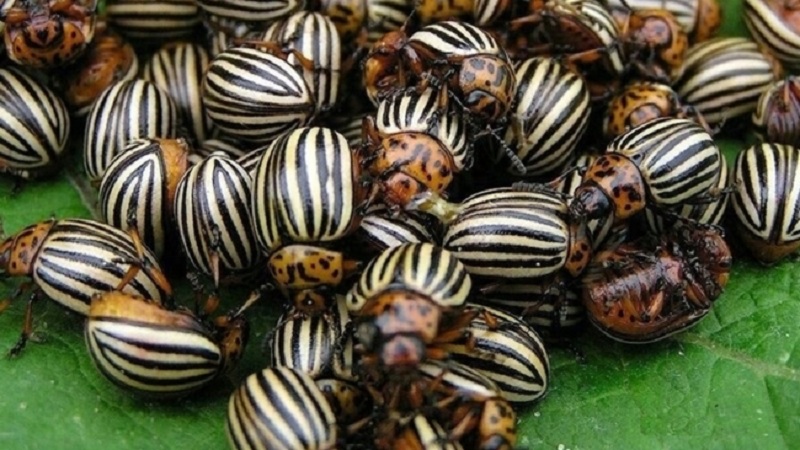
Leaves feed not only beetles, but also their larvae, causing irreparable damage. If measures are not taken in time to combat the Colorado potato beetle, the eggplants will remain without foliage.
Insecticides are the best anti-beetle remedy. But with ovary formation and the constant collection of fruits is not recommended. You can get rid of Colorado beetles without chemistry. Pest collection by hand, spraying the eggplant with garlic broth, dusting the plantings with ash will save the day.
Spider mite
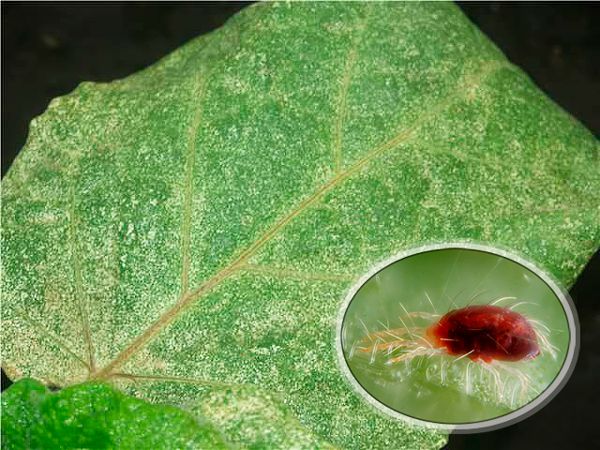
It lives on the underside of the leaves, sucks the juice out of them and enmeshes the plant with a white thin, but dense cobweb.
Important! Before spraying the bushes, manually remove all the cobwebs. Spraying is carried out exclusively on the undersides of the leaves.
How to process eggplant:
- acaricides "Floromite", "Sunmite" - the interval between spraying should not exceed 5 days;
- infusions from plants with a pungent odor (garlic, calendula, onions) - they will not help get rid of an already appeared spider mite, but they will scare away.
Whitefly
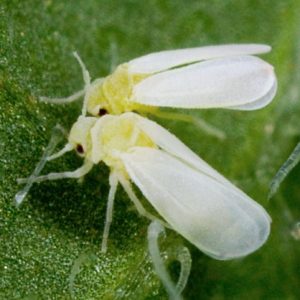
Butterfly eating eggplant juice. Lives on the underside of the leaf, the danger is posed by its secretions, which favor the development of fungi.
Spraying with "Fitoverm" and "Aktara" will help to destroy the whitefly.
Medvedka
Lives in the ground, feeds on roots. As a result, the plant dries up. There will always be bear burrows not far from the plantings, around which it is necessary to scatter Medvetox.
The classic measures include sprinkling the soil with ground pepper, watering with broths of onions and garlic.

Cruciferous flea
A small black beetle that completely devours the foliage, leaving only tough veins. Flea larvae reside in the ground and feed on roots.
Of the chemicals, insecticides such as Actellik help to combat cruciferous flea beetles.
Spraying with an infusion of wormwood, dandelion, garlic, or dusting with wood ash or ground pepper also gives results.
Slugs
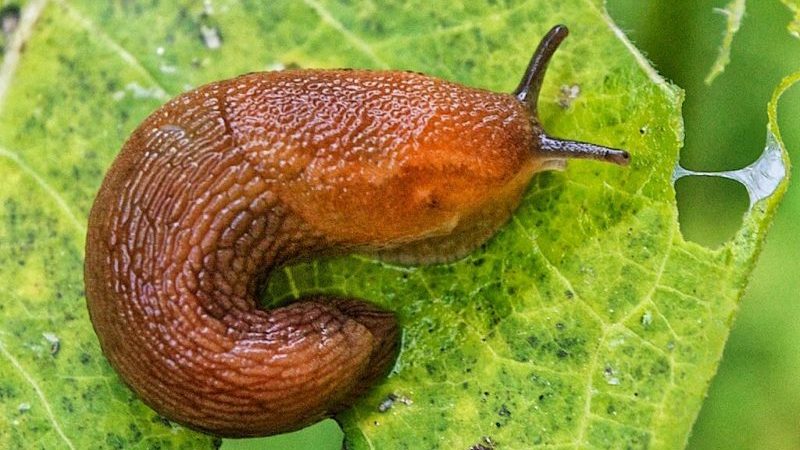
Gluttonous molluscs that feed not only on foliage, but also on the fruits of the plant. They crawl out of hiding places at night and leave behind slimy paths and large holes in the leaves.
The most effective method for fighting slugs is a powder containing metaldehyde. It is used in an amount of 3 g per 1 m². Coarse salt or ground pepper is also scattered around the eggplant beds.
Prevention measures
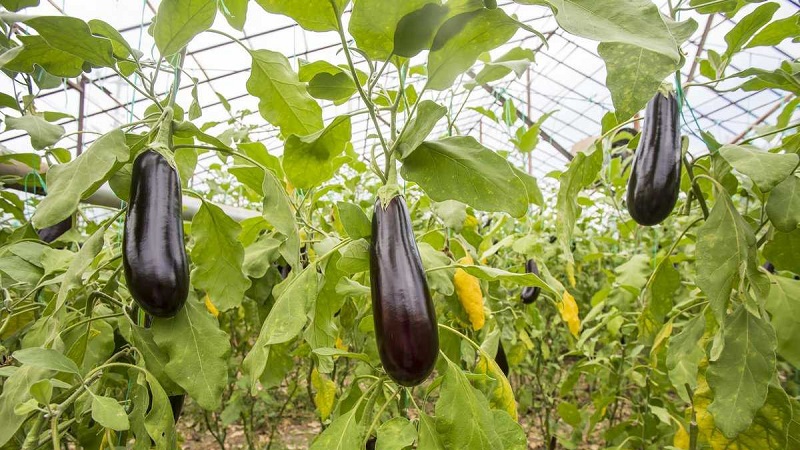
Preventive measures include:
- disinfection of seeds;
- compliance with the rules of crop rotation;
- disinfection of soil before planting;
- thinning dense plantings;
- compliance with the rules of watering and feeding;
- timely removal of weeds and plant debris from the site.
Conclusion
Eggplant is a delicate culture that, under unfavorable conditions and of poor quality leaving exposed to numerous diseases and pest attacks. Regular care and timely preventive measures will help avoid the problems described in the article and get a high yield.